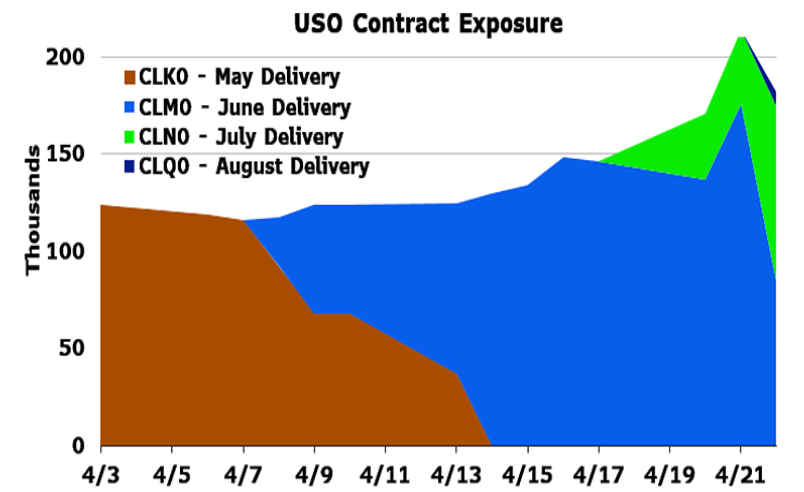These are not the futures that went negative, those were the rolled-off May's but what's going on is the reason we titled yesterday's post "Oil End Game: B.O.H.I.C.A., B.O.H.I.C.A.":
For folks too young to remember, B.O.H.I.C.A. was the acronym much in use during the worst of the market meltdown during October 2008—the market kept falling until March 2009 but October '08 was really bad for the longs.Here's ZeroHedge with the headline story later on Monday morning:
The acronym stands for Bend Over Here It Comes Again.
CME WTI June futures are down $4.18 (24.75%) at $12.76.
While the culprits behind last week's historic oil plunge to a negative $40/barrel have yet to be conclusively identified, with some pointing fingers at US retail traders, while others blaming tremendous losses in Chinese structured products, one clear usual suspect is the USO, the largest oil ETF and the preferred crude oil investment derivative for thousands of retail investors everywhere. As Bloomberg's Laura Cooper writes, oil trading negative last week brought to light the risks inherent in ETF’s easy liquidity: "while the market appears to be viewing the USO episode as an outlier, proof that funds can become unhinged from their benchmark leaves risk assets exposed."
Of particular interest remains the composition of USO's WTI futures holdings, with some speculating that the nearly 100,000 barrels held for May delivery may have precipitated the liquidation wave observed last Monday. Well, as it turns out, the CFTC data was actually stale, because as Bloomberg writes this morning, the USO wasn’t holding May WTI futures last Monday as it began rolling its underlying assets to June futures contracts in early to mid April – by construction to avoid trading complications near the date of contract expiry.
Even so, the tumble in both May WTI and USO quickly became a mutually reinforcing - and self-fulfilling - prophecy, and as the June price tumbled towards zero as May collapsed, the risk of liquidation from a negative NAV prompted the fund to take the unprecedented step to change its structure to lessen sensitivity to the moves and shift its mandate for future flexibility.
The chart below courtesy of Bloomberg summarizes how the USO - which historically only held the forward month leading to much pain during times of contango when the USO suffered major losses as it rolled its contract into a more expensive one - changed its composition in the past three weeks, through late Friday.
These color-coded changes in the USO's exposure to carious WTI contracts reflect the ETF's ongoing near-death experience as the fund's managers scrambled to prevent it from going negative - and liquidating - by dumping the fund's traditionally extensive exposure to the front, June contract month which - if last Monday's is any indication - would go negative next.
Then, in the latest update published this morning, the USO announced it was getting out of the June WTI contract altogether, rolling out of the June contract on April 27, 2020 through April 30, 2020, well ahead of the scheduled roll out which was supposed to take place on May 5-8th, while adding to other, longer-dated contracts. And as it sells June, this is what the USO is buying as per the latest 8K:...MUCH MORE
With USO manager, USCF, saying it will roll the current portfolio positions into the positions described above over a three-day period with approximately 33.3% of the investment changes taking place each day on each of April 27, 2020, April 28, 2020, and April 29, 2020, that explains why the June WTI contract is tumbling this morning as traders frontrun the USO selling....
- 30% of its portfolio in the July contract,
- 15% of its portfolio in the August contract,
- 15% of its portfolio in the September contract,
- 15% of its portfolio in the October contract,
- 15% of its portfolio in the December contract,
- 10% of its portfolio in the June 2021 contract.
B.O.H.I.C.A. indeed, front (June) futures down another $2.02 (15.81%) at $10.76.
Also at ZH, late last night:
Mon, 04/27/2020 - 23:00
Crude Carnage Continues Across Asia As Another Futures Contract Roll Looms
